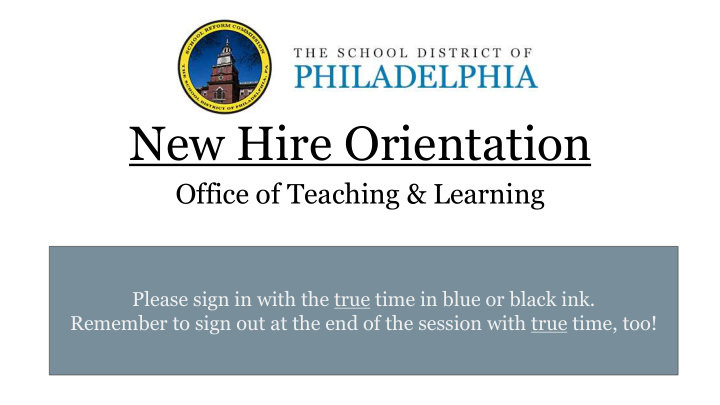



New Hire Orientation Office of Teaching & Learning Please sign in with the true time in blue or black ink. Remember to sign out at the end of the session with true time, too!
Connecting with Students with Disruptive Behaviors
Do Now Review the scenario in your Interactive Notes and answer the following prompts: ❏ Describe the disruptive behavior of the student in this scenario. ❏ What could be a possible cause of this behavior?
Agenda ✓ Objectives ✓ Connecting with Your Students ✓ Disruptive Behaviors & Triggers ✓ Strategies/Resources for Disruptive Students ✓ Behavior Analysis
Objectives Teachers will be able to… ❏ Leverage their knowledge of their students in order to make personal connections ❏ Select appropriate strategies and tools in order to proactively work together with students to prevent future negative behaviors
You’ve Gotta Connect! Connecting with Your Students James Sturtevant says: “...A positive, comfortable, and secure relationship with the teacher is at the heart of a safe classroom.”
Benefits of Connecting with Students ❏ Connections can foster trust between the students and the teacher ❏ Students who feel noticed by the teacher will learn best ❏ The classroom environment can be more productive ❏ Students have fewer behavior issues
Make A Commitment
Recognize Effective Connection Effective Connection IS: Effective Connection IS: • Being available • Acting warm and welcoming • Caring (and showing it) • Showing empathy • Treating students with respect • Exuding a love for teaching • Being a trustworthy confidant • Being a great listener • Showing belief in students • Accepting every student
Recognize Effective Connection Effective Connection Is NOT: Effective Connection Is NOT: • Acting like a peer • Using sarcasm • Trying too hard to be liked • Pampering students • Having vague boundaries • Failing to follow through • Having vague expectations • Demanding Respect • Being unable to say “no” • Pretending to Care
Student Surveys How do student surveys help you to connect with your students? Ms. K told us how she was from Poland. It helped I loved this survey me communicate because I want my with her better. teachers to know all - Amir, Grade 9 about me. If you don’t like your teacher though, you won’t want to open up to them about that stuff. - Nashay, Grade 6 I say kind words because I know Ms. A likes them. - Jahsir, Grade 3
Student Surveys Surveys can be completed ● Verbally ● Via “Thumbs up” ● On paper *By dictation if needed ● Digitally, i.e. Plickers, Poll Everywhere, Socrative, Today’s Meet *Do what works best for you & your students
Student Surveys What are some questions you would ask on a student survey to help you make connections?
Student and/or Classroom Profiles ● Observe students as they work (and play) ● Note strengths, interests, and areas of growth for every student ○ Affective ○ Behavioral ○ Cognitive
Using Info about Students
Using Info. About Students How to leverage student knowledge *See interactive notes scenario for interacting with two different students
Disruptive Behaviors and Triggers A trigger is something that causes something else to happen. What might cause a student to refuse to complete an assignment?
Disruptive Behaviors and Triggers ❏ Look at the list of disruptive behaviors in interactive notes. ❏ Within your group, discuss potential triggers for the behaviors. ❏ Be prepared to share out with the whole group.
Share Out ❏ Did you have any Aha! moments while listening to the group share out? ❏ Can you think of any other possible triggers or antecedents?
Behavior Analysis The A-B-C’s of Behavior A B C Antecedent Behavior Consequences/ (Or Trigger) Follow-up
❏ Ensure safety of the child and others De-escalation Strategies ❏ Talk slowly with a low tone of voice and limit body movements ❏ Calm yourself with deep breathing; the child will imitate you ❏ Ensure the child that you want to help him or her ❏ Eliminate loud noises and minimize the number of people in the vicinity ❏ Have child focus on something outside of the body (i.e. counting tiles) ❏ Provide a calm and quiet space ❏ Don’t lecture or ask a lot of questions ❏ Minimize verbalization
Critical Components of an Empathetic Conference ❏ Empathy ❏ Eye Contact ❏ Tone & body language ❏ Fosters connection ❏ Not a “Blame Game” ❏ Use of “I statements” ❏ It is about responsibility ❏ No judgment ❏ Wrap Up with a Handshake and a Next Step
Empathetic Conference Role Play
Strategies/Resources for Disruptive Students ❏ Empathetic Conference ❏ Behavior Trackers *Handout example ❏ Behavior Contracts *Handout example ❏ Learning Contracts
Other Resources
Behavior Analysis ● Read the scenario for your number on Page 7 of interactive notes ● Identify the trigger ● Identify a positive resolution
Share Out Provide feedback to other groups referring to the reflection ❏ Did you have any Aha! moments while listening to the groups share out? ❏ Can you think of any other possible strategies to use with this student?
Coming Together in Closing

Recommend
More recommend